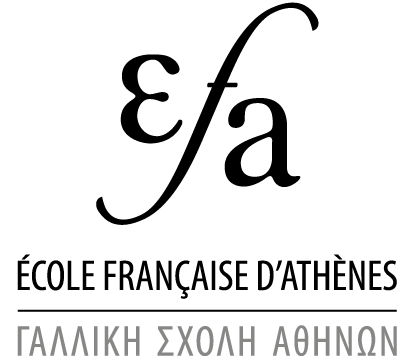Although Delos owed its urban expansion to its port and its importance in trade to the Hellenistic era, its religious status initially brought it prestige from Archaic times onwards: it was thought to be Apollo's birthplace and, as such, possessed a famous sanctuary, about the functioning of which during Delos' Independent period and its time as an Athenian colony (314 – c. 90) we are exceptionally well informed. Indeed, the religious history of Delos can be constructed primarily from epigraphic and archaeological data, rather than literary sources, which are relatively limited.
Delian cults in the Archaic and Classical eras
The Archaic and Classical eras were first and foremost marked by the architectural development of the sanctuary that the Homeric Hymn presents as that of all the Ionians (p. 33), and which some of them, Naxians (6, 9, 36 and 55), Ceians (see 48), Andrians (see 43), Carystians (see 16), Athenians (12 and perhaps 42) and others, contributed to building; there followed the interventions of Athens, which was responsible for the two 'purifications' of Delos, under Peisistratus and in 426.
-
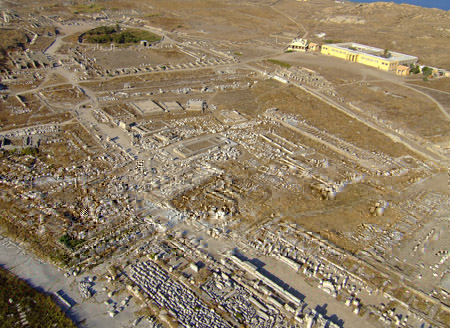
- The sanctuary of Apollo. Overall view.
Along with the deposit of young people's hair at the Sema, the geranos or dance of the crane, the flagellation around the altar, the biting of the olive tree, and the songs and dances of the girls of Delos, the arrival of the Hyperborean offerings formed the most traditional part of the Delian ritual. Festivals and theoriai were additional elements of cult practices on Delos. A passage from the Homeric Hymn (ll. 146-155), partly reproduced by Thucydides (3.104), describes the Ionian panegyrics of the Archaic era and the games that took place there:
'But when your heart, Phoebus, finds the most charm at Delos, it is when the Ionians in trailing tunics assemble in your squares, with their children and their chaste wives. Faithfully, to please you they engage in boxing, in dancing and singing, as they celebrate their games. Anyone coming upon the Ionians in their assembly would believe them immortal and forever exempted from ageing; he would see the grace of them all, and his heart would be charmed as he looked at the men, the women with their fine belts, the swift vessels with all their goods.'
There were also the theoriai, the delegations sent by cities to Delos. In addition to presenting an offering, a phiale for example, sometimes they were accompanied by festivals. This was the case with the Athenian Delia, about which it seems there were rules already in the Solonian era and which were reorganised in 426: from then on they were celebrated every four years (so-called 'penteteric' festivals). Plutarch (Nicias 3) describes their splendour in the year when they were held by Nicias (it was on this occasion that he offered to Apollo the bronze palm tree, 37).
Cults in the Hellenistic era
It is the Hellenistic era – and to be precise, from an epigraphic point of view, from 314 onwards – for which our knowledge of cultural life on Delos is best. This is because the state of the evidence is particularly favourable, for two reasons:
- In archaeological terms, the condition of Delos in Hellenistic times is best known. This is all the more to the good because the Hellenistic era is exactly the time when, historically, cultural life on Delos experienced its broadest growth, with a large number of sanctuaries.
- In epigraphic terms, for this period we have a considerable mass of inscriptions that are of relevance to religious history: several hundred dedications, from both groups and individuals, which were offered to all kinds of divinities, Greek and non-Greek; on the other hand, the 'archives of the sacred supplies', i.e. the 'accounts' of the management of Apollo's fortune and the 'inventories' of precious items preserved in the buildings that were overseen by the Sanctuary's administration.
Gods and goddesses
The gods and goddess whose cult is attested, one way or another, at Delos (even if only once), constitute an impressive list that goes from Apollo and Dionysus to the Egyptians Sarapis and Isis (cf. 91), to the God Most High (Theos Hypsistos) of the Jews (80) and the Arabian Sin (109). From neither a mythological or cultural perspective, however, did they form an organised pantheon of which the members were interrelated; on the contrary, many of them never encountered each other. Indeed, historically they can be divided into two distinct groups:
- from 314 the Delians honoured (local deities like Anios, Glaukos and Brizo aside) the great majority of Greek gods, not only the Apollonian triad and the gods more important on the island than elsewhere such as Eileithyia, but Zeus, Dionysus, Asclepius and so on. Some of these deities had a special role: Hermes, for example, was patron of the gymnasium, and Aphrodite of certain magistrates.
-
from the end of the third century, and more and more in the course of the following century, foreign deities were established at Delos, both eastern ones such as Sarapis and Isis, the Syrian pair Hadad and Atargatis (98) and Berytian Poseidon (57), and Italian ones such as the Lares Compitales.
-
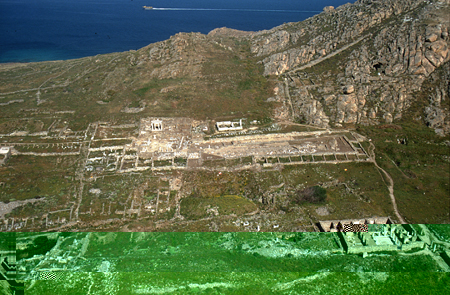
- The Terrace of the foreign gods
The non-Greek deities were initially of interest only to the foreigners who, having come to conduct trade at Delos, had brought them there: the gods of the Poseidoniasts from Berytos, as their dedications show, were their 'paternal gods' (57). Once they were established, however, they could attract followers from elsewhere, to the extent that some cults, instead of remaining private, were made official: this was the case, from c. 180 onwards, with the cult of the Egyptian deities, one of whose sanctuaries, Sarapeion C (100), was taken over by the administration of the Sanctuary of Apollo, and the same happened with the cult of the Syrian deities (98).
Sanctuaries
With so many gods and goddesses, Delos of course had dozens of sanctuaries, although some of them were for more than one deity, such as Zeus Kynthios and Athena Kynthia in the Kynthion (105), Demeter and Kore in the Thesmophorion, and many eastern deities who often, as some inscriptions from the Egyptian sanctuaries say, had 'a shared temple and altar'.
At the time of Delos' zenith, c. 100 BC, the sanctuary of Apollo, the focal point of the island and the heart of its urban development, formed a large space of a roughly trapezoidal shape, with several entrances, of which the most important was the Athenian propylaea (5) to the south. As for what it contained, the impression given must have been above all one of a jumble of items, without a proper Sacred Way that made it possible to move round all the monuments that had been added and juxtaposed and were of very different dates, sizes, techniques, orientations and purposes. If one seeks a programme or preconception, the only logic that can be discerned from the prevailing anarchy seems to be – at some points – that of alignment with the nearest neighbour. In this way, as at Delphi and at Olympia, some treasuries or buildings thought to be treasuries (16-20) were established next to each other in the northern half of the sanctuary, tracing a slight circular section turned towards the port, or else to the three temples of Apollo (11-12-13) and the altar of horns or Keraton (39).
-
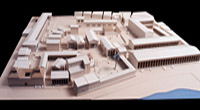
- The sanctuary of Apollo. Reconstructed model
-
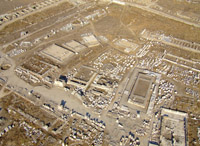
-
The Sanctuary of Apollo.
The three temples (11-12-13) and the treasuries (16-20)
The layout of the sanctuaries varied considerably. Those of the Greek deities were very different in their extents; in some cases they were limited to a chapel (68, 81) or a temple and its altar, like the Heraion (101), or, conversely, occupied a huge surface area, like the ancient 'Temenos of Leto' (53), and included several different buildings, for example the Dioscourion (123) and the Asclepieion (125), of which the function was to host sick people who had come to consult the god. The most original in appearance is the Cave of Cynthus (104), which is in the form of a grotto. Regarding the sanctuaries of eastern deities, their layout is appreciably different and more varied, given that they met particular liturgical requirements (hence the meeting hall of the rabbi and worshippers in the Synagogue (80) and, in the Syrian sanctuary (98), the theatre and terrace that were used for processions). In these sanctuaries of foreign deities established on Greek soil, it is interesting to observe the mixture of Greek and original tradition: for example, Sarapeion C (100) has, in the Egyptian fashion, a dromos lined with sphinxes, but the Temple of Isis and the statue of the goddess set up there are both in impeccably Greek style.
-
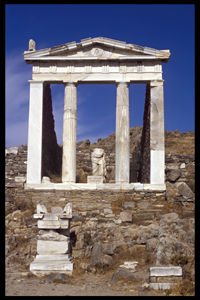
- The Temple of Isis
Cult staff and worshippers
Each sanctuary had its own 'clergy'; their composition in each case could vary greatly and underwent various modifications after the political changes of 167. During the Independent period, some of the sanctuaries were served by a priest (let it be recalled that, in ancient Greece, the priesthood was a civic office that demanded neither a personal vocation or membership of a set profession), others by a neokoros appointed by the sanctuary, and others by a priest and a neokoros. After 167, the neokoroi were replaced by priests who, like all the priests in service on Delos, were then Athenian citizens.
We know very little about worship, and especially the religious feelings that inspired it. Nevertheless, the inventories of the temple treasuries, dedications, and lists of subscribers provide useful information. Accordingly, these inscriptions draw attention to a clear contrast between the decline of old cults such as those of Hera and Leto, who received virtually no private offerings in the whole Hellenistic period, and the favour experienced by new cults, like that of the Egyptian deities who, conversely, benefited from hundreds of offerings. In their case, it is even possible to draw up long lists of devotees and to gain a reasonably good understanding of their chronological, ethnic and social distribution.
